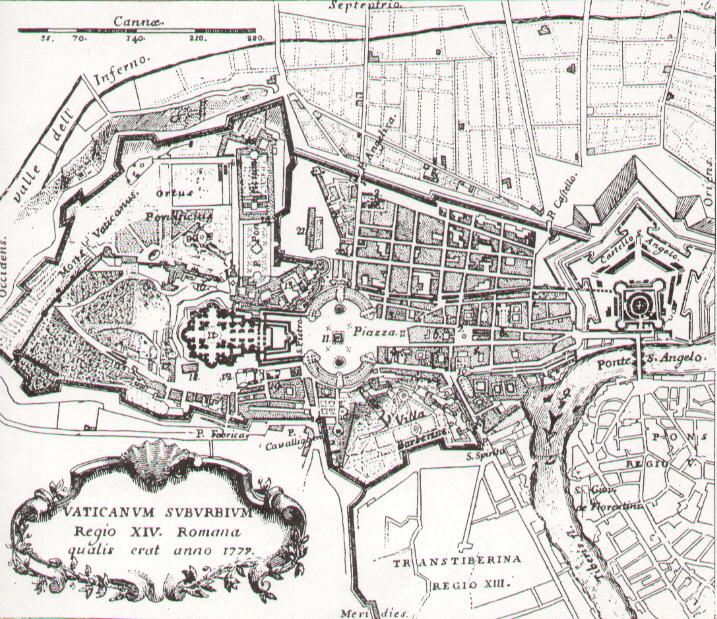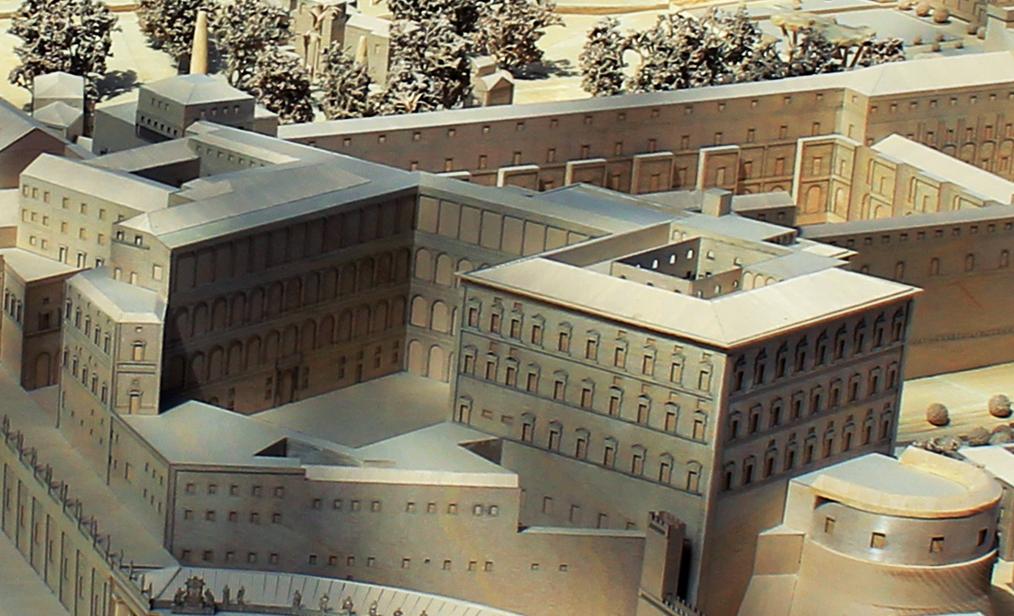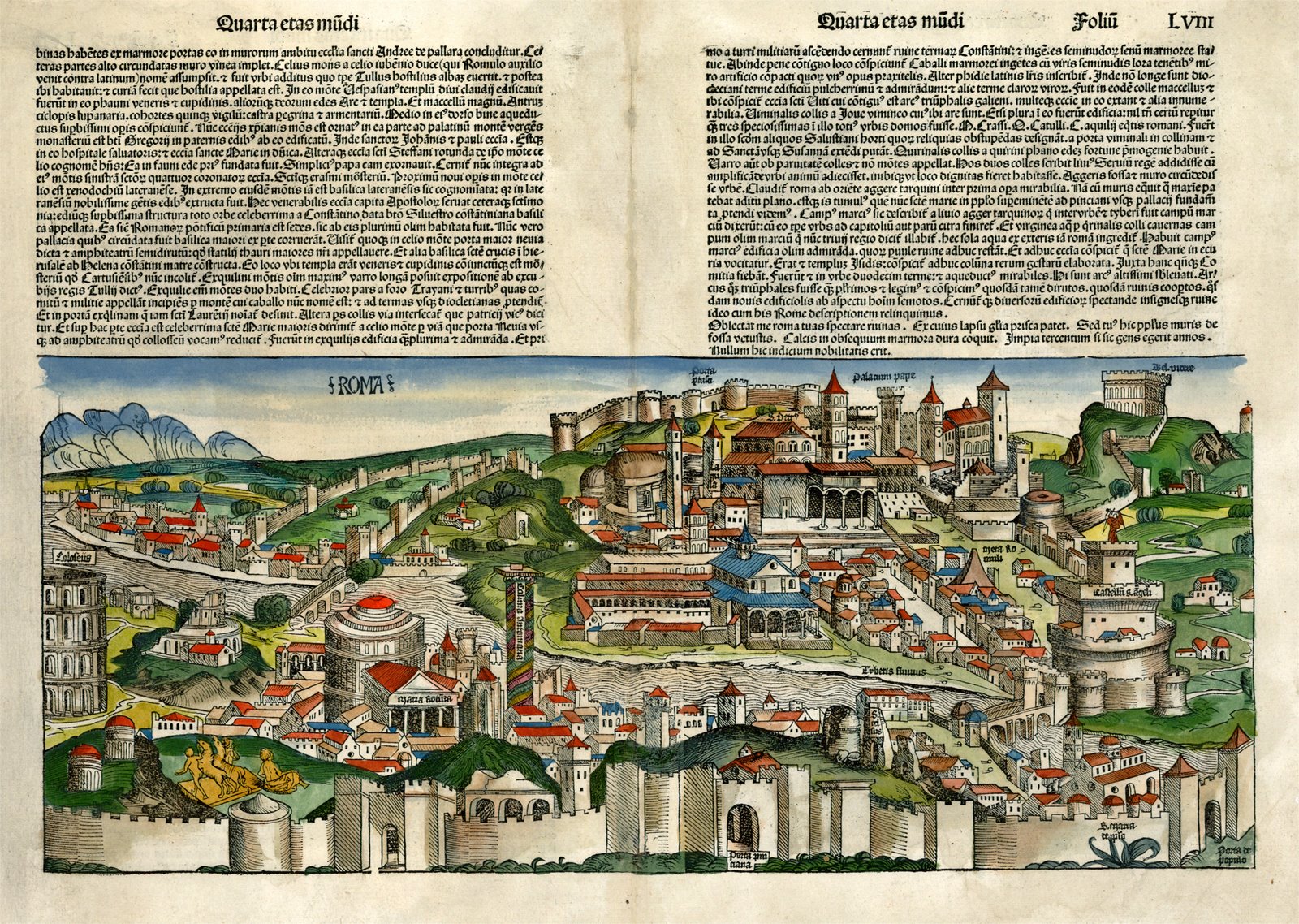|
Borgo Nuovo (Rome)
Borgo Nuovo, originally known as via Alessandrina, also named via Recta or via Pontificum, was a road in the city of Rome, Italy, important for historical and architectural reasons. Built by Pope Alexander VI Borgia () for the holy year of 1500, the road became one of the main centers of the high Renaissance in Rome. Borgo Nuovo was demolished together with the surrounding quarter in 1936–37 due to the construction of Via della Conciliazione. Location Located in the Borgo '' rione'', the straight road stretched in E–W direction, between ''Piazza Pia'', which marks the entrance of the quarter near the right bank of the Tiber, and the north edge of ''Piazza Rusticucci'', which until its demolition was the vestibule of Saint Peter's Square. At about two thirds of its length, Borgo Nuovo crossed '' Piazza Scossacavalli'', the center of the Borgo. Together with the nearby road of Borgo Vecchio, of probable Roman origin, Borgo Nuovo delimited the so–called ''sp ... [...More Info...] [...Related Items...] OR: [Wikipedia] [Google] [Baidu] |
Borgo (rione Of Rome)
Borgo (sometimes called also I Borghi) is the 14th ''rione'' of Rome, Italy. It is identified by the initials R. XIV and is included within Municipio I. Its coat of arms shows a lion (after the name "Leonine City", which was also given to the district), lying in front of three mounts and a star. These – together with a lion rampant – are also part of the coat of arms of Pope Sixtus V, who annexed Borgo as the 14th rione of Rome. History Roman Age: ''Ager Vaticanus'' During the Roman age, the Borgo district was part of the 14th Regio (Regio XIV Transtiberim) and was named ''Ager Vaticanus'', after the auguries (''vaticinii'') performed there by the Etruscan ''Augurs''. Since it lay outside the Pomerium (the religious city border inside which burial was forbidden) and was plagued by malaria, this territory was used as a burial place. Some tombs reached notable proportions, including the '' Terebinthus Neronis'', which was a round tomb surmounted by a narrow tower, and the ''Me ... [...More Info...] [...Related Items...] OR: [Wikipedia] [Google] [Baidu] |
Castel Sant'Angelo
The Mausoleum of Hadrian, usually known as Castel Sant'Angelo (; English: ''Castle of the Holy Angel''), is a towering cylindrical building in Parco Adriano, Rome, Italy. It was initially commissioned by the Roman Emperor Hadrian as a mausoleum for himself and his family. The building was later used by the popes as a fortress and castle, and is now a museum. The structure was once the tallest building in Rome. Hadrian's tomb The tomb of the Roman emperor Hadrian, also called Hadrian's mole, was erected on the right bank of the Tiber, between AD 134 and 139. Originally the mausoleum was a decorated cylinder, with a garden top and golden quadriga. Hadrian's ashes were placed here a year after his death in Baiae in 138, together with those of his wife Sabina, and his first adopted son, Lucius Aelius, who died in 138. Following this, the remains of succeeding emperors were also placed here, the last recorded deposition being Caracalla in 217. The urns containing these ashes wer ... [...More Info...] [...Related Items...] OR: [Wikipedia] [Google] [Baidu] |
Apostolic Palace
The Apostolic Palace ( la, Palatium Apostolicum; it, Palazzo Apostolico) is the official residence of the pope, the head of the Catholic Church, located in Vatican City. It is also known as the Papal Palace, the Palace of the Vatican and the Vatican Palace. The Vatican itself refers to the building as the Palace of Sixtus V, in honor of Pope Sixtus V, who built most of the present form of the palace. The building contains the papal apartments, various offices of the Catholic Church and the Holy See, private and public chapels, Vatican Museums, and the Vatican Library, including the Sistine Chapel, Raphael Rooms, and Borgia Apartment. The modern tourist can see these last and other parts of the palace, but other parts, such as the Sala Regia (Regal Room) and Cappella Paolina, had long been closed to tourists, though the Sala Regia allowed occasional tourism by 2019. The Scala Regia (Regal Staircase) can be viewed from one end and used to enter the Sala Regia. The Cappe ... [...More Info...] [...Related Items...] OR: [Wikipedia] [Google] [Baidu] |
Charles VIII Of France
Charles VIII, called the Affable (french: l'Affable; 30 June 1470 – 7 April 1498), was King of France from 1483 to his death in 1498. He succeeded his father Louis XI at the age of 13.Paul Murray Kendall, ''Louis XI: The Universal Spider'' (New York: W. W. Norton & Company, 1971), pp. 373–374. His elder sister Anne acted as regent jointly with her husband Peter II, Duke of BourbonStella Fletcher, ''The Longman Companion to Renaissance Europe, 1390–1530'', (Routledge, 1999), 76. until 1491 when the young king turned 21 years of age. During Anne's regency, the great lords rebelled against royal centralisation efforts in a conflict known as the Mad War (1485–1488), which resulted in a victory for the royal government. In a remarkable stroke of audacity, Charles married Anne of Brittany in 1491 after she had already been married by proxy to the Habsburg Holy Roman Emperor Maximilian I in a ceremony of questionable validity. Preoccupied by the problematic succession in th ... [...More Info...] [...Related Items...] OR: [Wikipedia] [Google] [Baidu] |
Passetto Di Borgo
The Passetto di Borgo, or simply Passetto, is an elevated passage that links the Vatican City with the Castel Sant'Angelo. It is an approximately corridor, located in the rione of Borgo. It was erected in 1277 by Pope Nicholas III, but parts of the wall were built by Totila during the Gothic War. On at least two occasions it served as an escape route for Popes in danger. Pope Alexander VI crossed it in 1494, when Charles VIII invaded the city and the pope's life was in peril. Clement VII escaped to safety through this passage during the Sack of Rome in 1527, when troops of the Holy Roman Emperor, Charles V, massacred almost the entire Swiss Guard on the steps of St Peter's Basilica. See also * Index of Vatican City-related articles *Vasari Corridor The Vasari Corridor ( it, Corridoio Vasariano) is an elevated enclosed passageway in Florence, central Italy, connecting the Palazzo Vecchio with the Palazzo Pitti. Beginning on the south side of the Palazzo Vecchio, it ... [...More Info...] [...Related Items...] OR: [Wikipedia] [Google] [Baidu] |
Pope Sixtus IV
Pope Sixtus IV ( it, Sisto IV: 21 July 1414 – 12 August 1484), born Francesco della Rovere, was head of the Catholic Church and ruler of the Papal States from 9 August 1471 to his death in August 1484. His accomplishments as pope included the construction of the Sistine Chapel and the creation of the Vatican Library. A patron of the arts, he brought together the group of artists who ushered the Early Renaissance into Rome with the first masterpieces of the city's new artistic age. Sixtus founded the Spanish Inquisition through the bull ''Exigit sincerae devotionis affectus'' (1478), and he annulled the decrees of the Council of Constance. He was noted for his nepotism and was personally involved in the infamous Pazzi conspiracy. Early life Francesco was born to a family of modest means from Liguria, Italy, the son of Leonardo della Rovere and Luchina Monleoni. He was born in Celle Ligure, a town near Savona. As a young man, Della Rovere joined the Franciscan Order, a ... [...More Info...] [...Related Items...] OR: [Wikipedia] [Google] [Baidu] |
Old Saint Peter's Basilica
Old St. Peter's Basilica was the building that stood, from the 4th to 16th centuries, where the new St. Peter's Basilica stands today in Vatican City. Construction of the basilica, built over the historical site of the Circus of Nero, began during the reign of Emperor Constantine I. The name "old St. Peter's Basilica" has been used since the construction of the current basilica to distinguish the two buildings. History Construction began by orders of the Roman Emperor Constantine I between 318 and 322, and took about 40 years to complete. Over the next twelve centuries, the church gradually gained importance, eventually becoming a major place of pilgrimage in Rome. Papal coronations were held at the basilica, and in 800, Charlemagne was crowned emperor of the Holy Roman Empire there. In 846, Saracens sacked and damaged the basilica. The raiders seem to have known about Rome's extraordinary treasures. Some holy—and impressive—basilicas, such as St. Peter's Basilic ... [...More Info...] [...Related Items...] OR: [Wikipedia] [Google] [Baidu] |
Roman Renaissance
The Renaissance in Rome occupied a period from the mid-15th to the mid-16th centuries, a period which spawned such masters as Michelangelo and Raphael, who left an indelible mark on Western figurative art. The city had been a magnet for artists wishing to study its classical ruins since the early 1400s. A revived interest in the Classics brought about the first archaeological study of Roman remains by the architect Filippo Brunelleschi and sculptor Donatello. This inspired a corresponding classicism in painting and sculpture, which manifested itself in the paintings of Masaccio and Uccello. Pisanello and his assistants also frequently took inspiration from ancient remains, but their approach was essentially cataloguing, acquiring a repertoire of models to be exploited later. In the year 1420, Pope Martin V moved the papal seat back to Rome, ending its long "Babylonian captivity", and after the Papal Schism, when several "popes" simultaneously claimed the office. He at once set ... [...More Info...] [...Related Items...] OR: [Wikipedia] [Google] [Baidu] |
Monti (rione Of Rome)
Monti is the 1st '' rione'' of Rome, identified by the initials R. I, located in Municipio I. The name literally means "mountains" in Italian and comes from the fact that the Esquiline, the Viminal Hills, and parts of the Quirinal and the Caelian Hills belonged to this ''rione'': currently, however, the Esquiline Hill belongs to the rione Esquilino. The coat of arms consists of three green mountains with three tops on a silver background. History In ancient times, the ''rione'' was densely populated; Monti was home to the Forum Romanum and the so-called ''Suburra,'' where poor people lived, full of disreputable locals and brothels. In the Middle Ages the situation was completely different: the Roman aqueducts were damaged, and it was very difficult to bring water to Monti since it was on the hills. Hence many inhabitants moved to Campus Martius, a lower level part, where they could drink the water from the river Tiber. From the Middle Ages to the beginning of the 19th cen ... [...More Info...] [...Related Items...] OR: [Wikipedia] [Google] [Baidu] |
Piedmont
it, Piemontese , population_note = , population_blank1_title = , population_blank1 = , demographics_type1 = , demographics1_footnotes = , demographics1_title1 = , demographics1_info1 = , demographics1_title2 = , demographics1_info2 = , demographics1_title3 = , demographics1_info3 = , timezone1 = CET , utc_offset1 = +1 , timezone1_DST = CEST , utc_offset1_DST = +2 , postal_code_type = , postal_code = , area_code_type = ISO 3166 code , area_code = IT-21 , blank_name_sec1 = GDP (nominal) , blank_info_sec1 = €137 billion (2018) , blank1_name_sec1 = GDP per capita , blank1_info_sec1 = €31,500 (2018) , blank2_name_sec1 = HDI (2019) , blank2_info_sec1 = 0.898 · 10th of 21 , blank_name_sec2 = NUTS Region , blank_info_sec2 = ITC1 , website www.regio ... [...More Info...] [...Related Items...] OR: [Wikipedia] [Google] [Baidu] |
Alessandria, Italy
Alessandria (; pms, Lissandria ) is a city and '' comune'' in Piedmont, Italy, and the capital of the Province of Alessandria. The city is sited on the alluvial plain between the Tanaro and the Bormida rivers, about east of Turin. Alessandria is also a major railway hub. History Alessandria was founded in 1168 with a charter as a free comune; it was sited upon a preexisting urban nucleus, to serve as a stronghold for the Lombard League, defending the traditional liberties of the communes of northern Italy against the Imperial forces of Frederick Barbarossa. Alessandria stood in the territories of the marchese of Montferrat, a staunch ally of the Emperor, with a name assumed in 1168 to honour the Emperor's opponent, Pope Alexander III. In 1174–1175 the fortress was sorely tested by the Imperial siege and stood fast. A legend (related in Umberto Eco's book '' Baudolino'', and which recalls one concerning Bishop Herculanus’ successful defence of Perugia several ce ... [...More Info...] [...Related Items...] OR: [Wikipedia] [Google] [Baidu] |








